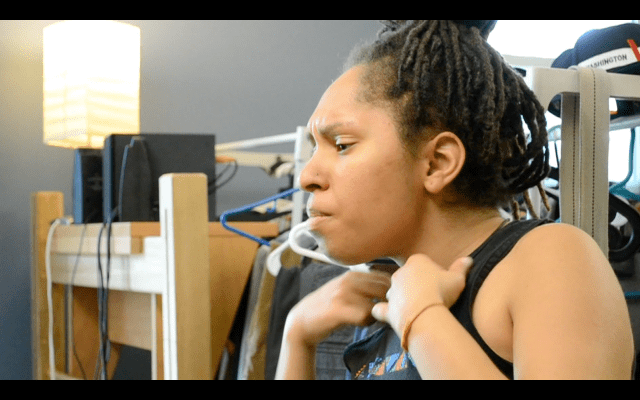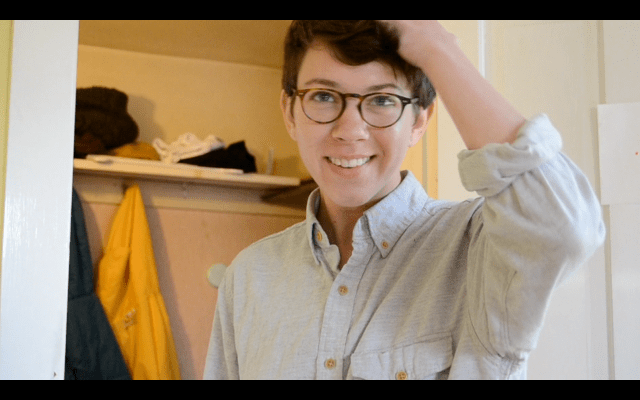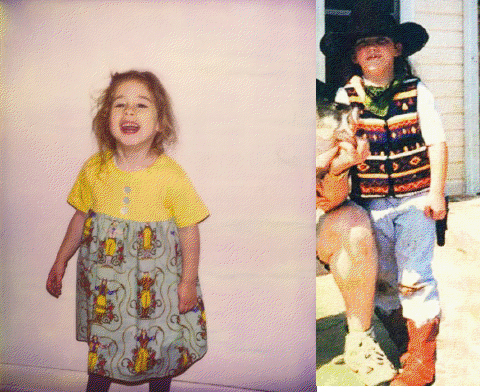By A.D. Hogan and Becca Kahn Bloch
Clothes are weird, magical things. They can make you feel invincible, giving you the confidence to pick up that girl at the bar — but they can also wrap you up in warm and fuzzies after a terrible breakup, comforting you with their oh-so-soft fleecy goodness and memories of times past. The right clothes can provide the secret password to getting in with a certain group—but they can also make you feel unique, differentiating you from the crowd. Whether they are off-the-rack, hand-stitched by your grandmother, found at Goodwill, or “borrowed” from a friend, clothes somehow give us this crazy way to express ourselves that’s kind of unlike anything else. And for queer people, figuring out ways to express ourselves is a big deal.

Knowing this, we made a documentary short, called gender, bespoke, about some of our favorite things: gender, clothing, and beautiful queer people. When we came up with the idea to make gender, bespoke, we were enrolled in a queer theory seminar. For our final, instead of writing a paper, we wanted to collaborate on a creative project —figure out how to take hyper-academic queer theory and translate it into our everyday lives. We both love fashion—(A.D. has this thing about obsessively documenting what she wears every day on her tumblr) — and we’re both super interested in gender, performativity, and queer presentation. And so we thought, what better way to show how queer theory manifests in our everyday lives than to look at what we wear? I mean, come on: we all know that queer women are obsessed with their clothes. Just take a look at any one of the hundreds of queer/lesbian fashion blogs on the interwebz right now. So what’s the deal? Is it just that queer ladies are super fashionable? Well, yeah. Duh. But there’s clearly something more going on here; queer women have an attachment to their clothing that transcends fashion and delves into issues of identity, legitimacy, and performance.

gender, bespoke provides a glimpse into the closets and minds of a few queer women at Oberlin College, a small liberal-arts college in Oberlin, OH. Bespoke is a term that means “handmade” or “made to order,” and so bespoke clothing is different from ready-made clothing. Ready-made clothing is what nearly everyone wears; it is made in general sizes (M, XL, 16½, etc.), and it is sewn by machine. The stitches in ready-made clothes are very tight and exact; they are stapled and forced. The stitches in bespoke clothes, however, are looser and “give” more. Bespoke clothes move and adjust and change through time as they move with one’s body. gender, bespoke, then, suggests a self-made and continually changing gender identity. The film traces the “stitching” of gender, identity, and fashion of each person.
The questions we explored in the process of making this film include: How does a gay/lesbian/queer person gain legitimacy through the daily micro-performances of getting dressed and being dressed? How can a literal closet affect the metaphorical closet, disclosing one’s identity to others? What do the interactions of gender, orientation, class, race, dis/ability, citizenship, globalism, etc., suggest (or perhaps explicitly convey) about one’s identity? What does clothing signify? Does clothing need to be worn to have its significance? Is this movie about the clothes or the person? Can you separate the two? What does clothing signify to the wearer? To “straight” people? To other queers?
Of course these questions are much larger than our short documentary conveys, but they serve as guiding markers throughout our work. We consider gender, bespoke to be one conversation in an ongoing dialogue about performativity, gender identity, and the everyday politics of queer.
We came at this project from very different perspectives. In some ways, the two of us are pretty similar. We’re both white, economically privileged (to varying extents) cis-women who identify as queer and attend an elite private college. But as far as how we dress, and how we relate to our clothing, the similarities end there. Becca identifies as a femme, with a closet full of dresses, cardigans, and scarves. A.D. likens her style to “sassy frat boy”—masculine prep with queer flair.

Though we both have pretty different styles, we both consider fashion to be a vital part of our coming-out stories, and how we negotiate our queerness.
For Becca, it went a little something like this:
I like to think that I’ve always been femme. Even when I was three, I could rock a cute sundress and tights like nobody’s business. Of course, there was the requisite tomboy/sports/cat-lady phase in middle school (hello baggy shorts and non-ironic cat t-shirts), but that was short lived.
During my sophomore year of high school, I first came out to myself, had my first (secret) girlfriend, and started hanging out with a group of cool, artsy seniors. All of this made me way more confident in myself, and subsequently affected my style. Gone were the baggy shorts and clogs (seriously? I know. Let’s just not talk about it.), and in their place was a closet full of skinny jeans, silk skirts, and of course the requisite contingent of American Apparel t-shirts. Once I started coming out—first to myself and then to others—I really started reveling in my femme presentation.
I like to think that it was because I finally felt like I could truly be myself, and that I didn’t have to hide anymore in nondescript clothing that covered me up and hid the real me from everyone else. But I also know that part of me knew that coming out meant that I would be susceptible to a lot of judgment, and so dressing femme was my way of combatting the stereotypes, and establishing myself as a lesbian on my own terms. When I was first coming out, it was comforting not having to constantly worry about being outed by my clothing. Having the safety net of femme presentation made my coming out process easier for me; skirts, heels, and makeup afforded me more control over who knew what about my identity, and when.
As I became more comfortable with myself and with my sexual orientation, I toned down the femme a bit. (A trip to Israel introduced fisherman’s pants to my wardrobe in a major way, much to my later chagrin.) But I realized that femme for me wasn’t just a safety net or a protective shield—I loved how I felt in dresses and makeup; they made me feel hot and confident and ready to take on the world. They made me feel like me.
But for A.D., it was a different story:
One of the first things I tell everyone is that I’m from Texas. Growing up, I was actually a cowgirl. I had two basic looks: cowgirl and sporty. If I wasn’t in jeans and boots, I was in baggy shorts and beating the boys in races. This didn’t change for years. In high school, I rocked skinny jeans and white v-necks for years. I loved the simplicity of this outfit. I could play viola in it; I could go to church; I could go to cafes. It said nothing, which is exactly what I wanted. I wanted to erase any signifiers of my evolving gender identity and sexuality.
During my coming out process, I was extremely paranoid about being read as a “lesbian” both by the community and the world at large. I didn’t want everyone to know my business; I just wanted the cuties to know my business. (Oh, come on. You know you want the same thing.)
Collared shirts and leather boots were definitely a good first step. I then realized that the long mass of curls on my head rendered me illegitimate and invisible in a lot of queer spaces. I was continually asked, “So, when are you cutting your hair?” and “Are you femme?” or even, “Why do you wear masculine clothing and have long hair?” (as if my gender incongruence was, like, the pinnacle sin against the Goddesses of Gaydom).
These questions lead my current rebellion; I’m a founding member of the long-hair-don’t-care club. My hair and my clothing are statements that complicate androgyny, female-bodied-ness, gender, class, and race in ways that are not at first apparent. I dress like a frat boy, but I queer my look with plenty of sass and gender nonconformity along the way. My clothing is definitely an attempt to pass as an identity (rich, white, privileged) that I sometimes occupy (white, masculine, educationally privileged), and sometimes don’t (rich, male).
For both of us, what we wore and how we wore it was incredibly important during our coming out processes. We were trying to figure out how we wanted to present ourselves, and what we wanted the world to see at first glance. Even though we headed in different style directions, both of us shed our non-descript, identity-hiding clothing after we came out. And both of us look to our clothing now to help us negotiate our queer identities in the world.
Making this documentary was a really exciting process for us because we were able to learn about other queer women’s complicated relationships with clothing. Just like us, the subjects in our film are constantly negotiating their queer identities through their clothing, and just like us, they consider their clothing to be intimately connected to their gender presentation. The five women (including A.D.) that we interviewed discussed topics such as passing, visible and invisible femininities, looking “gay enough,” and getting dressed as “drag.” It was such an incredibly cool experience to see our own thoughts and emotions about clothing and queerness reflected in what our subjects were saying, and also to hear about new issues and new ideas that we hadn’t personally experienced.
For Becca, Naomi’s discussion of femme invisibility was particularly resonant:
I can really identify with what Naomi said about how being read as straight can feel like “a certain erasure of your identity.” Being read as straight because of my dresses and makeup was comforting in high school when I was still coming out, but when I got to college, it was a problem—not an asset. It was frustrating to be overlooked in queer circles, or to feel as though others were wondering why that straight girl was there. Aside from the practical problem of being unable to get a date because everyone thought I was straight, being read as straight barred me from feeling like I was part of the queer community.
I wanted ways to differentiate myself from the pack, to let it be known to others that I was queer. And so I adopted some new—or emphasized some existing—queer signifiers, which Naomi and Hanna mention in the film. Industrial piercing? Check. Shaved part of the head? Check. Some new lids and a couple pairs of kicks? Double check.
Now don’t get me wrong—I still wear dresses. In fact, I pretty much only wear dresses now. (True story: some of my closest friends at Oberlin can’t remember ever seeing me in pants because I actually have not worn a single pair of pants while at college [late-night cramming for final exams sweatpants excluded].) So yeah, I’m still pretty femme. But I’m a different kind of femme in college than I was in high school.
For A.D., it was discussions of masculinity that were really interesting:
I really loved the masculinities that Meagan, Taylor, and Hanna embodied and discussed. Hanna talked a lot about feminine masculinity, and how they identified with gay male culture more than queer female/woman/FAAB/trans* culture. I am still so intrigued by this concept of non-female femininity found in gay-male culture, as well as the similarities between gay/lesbian/queer cultures.
I also really loved Meagan’s discussion of failure, and how she failed to be masculine enough. Through coming out, I continually felt like I wasn’t queer enough, out enough, gay enough, smart enough, alternative enough, or just simply enough. Once I started dating, I felt insufficiently queer/masculine/dominant in the bedroom, in the club, and in conversations. Through confessing her acceptance of her “shortcomings,” Meagan invited me to reconsider my own “failings.” Also, her term “sissy butch” is one on my new descriptors. Love it.

gender, bespoke is our attempt to show some examples of queer fashion and gender identity. Even though all of the subjects are Oberlin College students, we think that queer experiences are relatable across a broad range of identities and experiences, and that gender, bespoke is able to resonate beyond the borders of Oberlin and into the greater queer community. We also think it’s important to note that we deliberately chose not to include any trans* subjects in the film. When we were first planning the film, we talked about this at length—with each other, with our friends, with anyone who would talk to us. We had concerns about appropriately representing trans* bodies on film—we didn’t want to fetishize and we didn’t want to tokenize, especially given the history of trans* bodies on film. Ultimately, it came down to us, as queer cis-women, and as filmmakers, not feeling comfortable with potentially objectifying or otherwise exploiting trans* bodies.

The process of making gender, bespoke has been an amazing one. We’ve learned so much about ourselves, about our friends, and about queerness and gender presentation. It definitely got a little crazy at times—(frequent visitors to the editing studio included a bottle of whiskey and a healthy dose of insanity) — but it really has been eye-opening for us to hear other queer women’s stories, and be able to render them on film for the whole community to see. Plus we picked up a few fashion tips along the way.
Ultimately, what we took away from making this movie was that, for queer women, clothing is about much more than what you’re wearing. Clothing allows us to create an identity for ourselves—and to control how other people view us and consider us. What we’ve learned is that while each queer woman’s story may be different, clothing probably plays an important part in every one.
To get in touch with A.D. Hogan and Becca Kahn Bloch, email genderbespokedocumentary [at] gmail [dot]com







